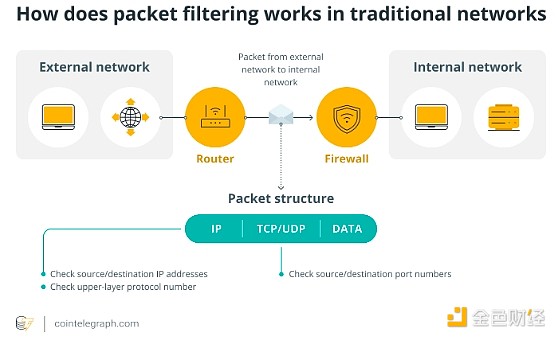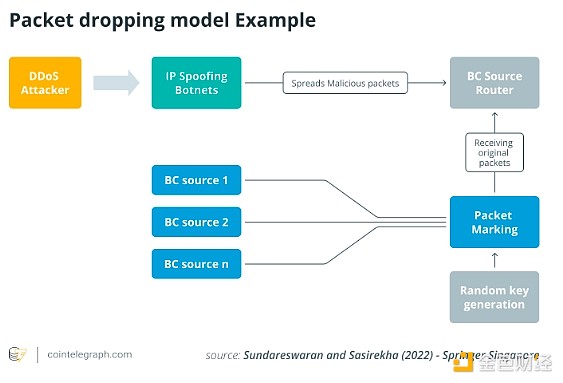Teardrop attacks in encryption: what they are and how to stop them

Reprinted from jinse
01/13/2025·3MAuthor: Onkar Singh, CoinTelegraph; Compiler: Deng Tong, Golden Finance
1. What is a teardrop attack in cryptocurrency?
Teardrop attacks exploit the way a system reassembles fragmented packets during transmission by sending overlapping fragments that the target system is unable to reconstruct correctly, causing a denial of service.
As the cryptocurrency ecosystem matures, the cyber threats that attack it become increasingly sophisticated. A teardrop attack is a denial of service (DoS) attack and is one such cyberattack. Teardrop attacks began as network- level vulnerabilities, and their adaptation to cryptocurrency systems highlights the ingenuity and versatility of malicious actors.
Imagine cutting a letter into parts and placing them in separate envelopes. Someone put the pieces back together at the destination to read the entire letter. A teardrop attack is like sending an envelope with missing or overlapping parts, making it impossible to recreate the original letter. Because of this confusion, the recipient may become overwhelmed and shut down.
But what does this have to do with cryptocurrencies?
Cryptocurrency systems rely heavily on network communications. Transactions, block propagation, and other basic functions involve sending data in packets over the Internet. These packets are reassembled by the nodes that maintain the blockchain and process transactions.
Teardrop attacks that target specific nodes or network participants attempt to interfere with regular operations to exploit weaknesses in wallets, exchanges, or blockchain networks. For example, by sending malformed packets, an attacker can overwhelm a server's reassembly process, causing it to crash or become unresponsive.
If the Teardrop attack works, it might open the door to other attacks. For example, when a server is unavailable or unable to reassemble packets, attackers may try to exploit other weaknesses to gain unauthorized access or change data.
Therefore, it is crucial to understand and address the consequences of such attacks, as they have the potential to compromise the integrity of blockchain networks.
2. How teardrop attacks target encrypted networks
In the cryptocurrency environment, teardrop attacks often target the decentralized nature of blockchain platforms. Even if they don’t target the blockchain’s cryptographic algorithms, disrupting the underlying peer-to-peer network infrastructure that cryptocurrencies rely on could lead to service disruptions, loss of funds, and loss of user trust.
An attacker can interfere with the consensus process, transaction validation, or node-to-node communication by focusing on specific nodes or servers. This can lead to network fragmentation, processing delays or even complete outages.
For example, an attacker could flood critical nodes in permissionless blockchains (such as Bitcoin) or validating nodes in permissioned blockchains with erroneous packets, rendering them inoperable. Since nodes rely on regular communication to reach consensus, these disruptions can lead to vulnerabilities that allow attackers to exploit network anomalies.
For example, if some nodes are temporarily disconnected or inoperable, attackers may try to manipulate data flows, trigger double-spend attacks or introduce erroneous transactions.
Additionally, teardrop attacks can target services related to the blockchain ecosystem, such as wallet providers and cryptocurrency exchanges, rather than the blockchain infrastructure itself. These services primarily rely on continuous communication between users and servers to enable seamless transactions and service availability.
Teardrop attacks on exchanges could disrupt trading, withdrawals, and other critical services. In addition to negatively impacting specific users, this can damage the reputation of the exchange and potentially lead to losses for traders and investors. Additionally, frequent attacks or prolonged outages could cause users to lose confidence in the platform, thereby harming its user base.
3. The impact of teardrop attacks on encryption security and users
Teardrop attacks have far-reaching consequences for cryptocurrency systems. In addition to jeopardizing network security, they also undermine user trust.
Major impacts include:
-
Operational downtime: Network participants (such as nodes or validating entities) may experience outages that halt transaction processing.
-
Financial losses: Traders and investors may suffer financial losses due to delayed or failed trades, especially during periods of market volatility.
-
Data integrity risks: While teardrop attacks do not directly modify blockchain data, they may create opportunities for secondary attacks on ledger integrity.
-
Reputation damage: Cryptocurrency networks, exchanges or wallet providers may suffer prolonged outages or repeated attacks.
-
Exploit window: An attacker can exploit a network outage to distract system administrators to conduct further attacks, such as phishing or double-spending.
4. How to identify teardrop attacks
Minimizing the damage caused by a teardrop attack requires early recognition. If system administrators are aware of signs of risk, they can take action faster.
Here are the main signs of a teardrop attack:
-
Unexplained system crashes: Unexpectedly frequent crashes may indicate an attack on the system that targets the ability to reassemble fragmented packets.
-
Slow performance: Slower processing times or reduced responsiveness of a node or server may indicate an influx of malformed packets, overwhelming the system.
-
Error logs: Careful inspection of system logs may reveal patterns of overlapping or incomplete packets, which are typical of teardrop attacks.
-
Unusual network traffic: A sudden surge in fragmented packet traffic often indicates a teardrop attack. Abnormal trends can be spotted with the help of monitoring tools.
-
Connectivity issues: If nodes in the network are unable to communicate with each other, it could be a sign that the blockchain architecture is under attack.
5. Best Practices to Prevent Teardrop Attacks in Encryption
A proactive strategy that combines operational attention and technical assurance is needed to prevent teardrop attacks.
Packet filtering is often used in traditional networks to prevent disruptions such as DoS attacks, which are designed to overload the network with malicious data.

Simply put, packet filtering acts as a security checkpoint for data traveling over a network. Just like airport security personnel scan your luggage for dangerous items, packet filtering scans incoming packets to ensure they are safe.
In blockchain systems, it helps prevent malicious or faulty packets (such as those used in teardrop attacks) from entering network nodes.

Here are some other best practices to consider:
-
Decentralized architecture resilience: Strengthen decentralized blockchain nodes to ensure redundancy and fallback mechanisms to maintain normal network operation even if some nodes are attacked.
-
Rate Limiting and Traffic Shaping: Control the rate at which packets are delivered to nodes to reduce the impact of flooding attacks.
-
Regular software updates: Ensure all blockchain software, wallets, and trading platforms are updated to patch known vulnerabilities.
-
Educate and train employees: Equip teams with the knowledge to effectively identify and mitigate potential threats.
Combined with other defense techniques, packet filtering provides a powerful layer of protection to help secure cryptocurrency systems against evolving threats.
6. What to do if you fall victim to a cryptocurrency teardrop attack
Even with the strongest defenses, no system is completely immune to cyberattacks. Prompt action may mitigate the impact of a teardrop attack on your cryptocurrency system.
If you fall victim to a teardrop attack, here are some things you can do:
-
Isolate affected systems: To stop the attack from spreading, disconnect the hacked node from the network.
-
Analysis and Mitigation: Companies can use forensic tools and exhaustive logs to investigate the nature of the attack. To resolve an exploited vulnerability, apply the necessary updates or fixes.
-
Hire an incident response team: Leverage the knowledge of cybersecurity experts to aid containment and recovery.
-
Inform stakeholders: Clearly explain the issue to consumers and interested parties. Regular updates and transparency help maintain trust.
-
Strengthen defenses: Assess your system's security architecture after an attack and take preventive measures to prevent a recurrence. To find more vulnerabilities, perform penetration testing (simulating attacks to identify weaknesses).
-
Log Incidents: Record detailed logs of attacks and responses. This knowledge can be very helpful for future compliance and preparation.
It can be seen that the teardrop attack highlights the vulnerability of cryptocurrency systems in the face of complex cyber threats. By acting quickly and strengthening security measures, you can mitigate the impact and protect your network from future outages.


 chaincatcher
chaincatcher
 panewslab
panewslab